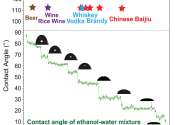Saturday Citations: Bulking tips for black holes; microbes influence drinking; new dinosaur just dropped
What did scientists do this week? Exactly four things, all of which are summarized below.

What did scientists do this week? Exactly four things, all of which are summarized below.

In a paper published in the journal Event Management, researchers have investigated the Gold Coast 2018 Commonwealth Games and its One Million Stars to End Violence (OMSTEV) campaign to see how effective such a campaign was ...
Social Sciences
Jun 18, 2024
0
0

Birds have been known to seek out pungent chemicals for various reasons. Some consume fermented fruits with gusto and suffer the ill effects. Others expose themselves to ants, but only the stinky kind. These ants produce ...
Plants & Animals
Jun 18, 2024
0
0

Spicy foods taste spicy because they contain a family of compounds called capsaicinoids. Capsaicin is the major culprit. It's found in chilies, jalapeños, cayenne pepper, and is even the active ingredient in pepper spray.
Analytical Chemistry
Jun 13, 2024
0
1

Minimum pricing can be very effective in reducing demand for cheap high-strength alcohol amid concerns about affordability fueling problematic drinking, according to a study on the impact of the measure during the COVID lockdown.
Economics & Business
Jun 5, 2024
0
0

No means no when it comes to sex. But what happens when a woman makes a more passive response to a sexual advance? According to new research from Binghamton University, men differ in how they interpret these types of responses, ...
Social Sciences
May 29, 2024
0
12

While ethanol in alcoholic beverages impairs drinkers' motor functions, it is that same substance that can power motor vehicles in a cleaner, more sustainable manner. What is necessary for the production of ethanol is yeast, ...
Cell & Microbiology
May 16, 2024
0
1

Safe and high-quality fertility preservation is of growing significance for women in clinical trials. Current primary methods for cryopreserving human oocytes are slow freezing and vitrification, but existing techniques pose ...
Bio & Medicine
May 15, 2024
0
1

Most alcohol enters the bloodstream via the mucous membrane layer of the stomach and the intestines. These days, the consequences of this are undisputed: even small amounts of alcohol impair people's ability to concentrate ...
Bio & Medicine
May 13, 2024
0
78

We all have our own preferred drinking temperatures for different alcoholic beverages, with people commonly enjoying beer or white wine chilled, red wine near room temperature, or baijiu (Chinese whisky) or sake warmed.
Analytical Chemistry
May 1, 2024
0
30
In chemistry, an alcohol is any organic compound in which a hydroxyl group (-OH) is bound to a carbon atom of an alkyl or substituted alkyl group. The general formula for a simple acyclic alcohol is CnH2n+1OH. In common terms, the word alcohol refers to ethanol, the type of alcohol found in alcoholic beverages.
Ethanol is a colorless, volatile liquid with a mild odor which can be obtained by the fermentation of sugars. (Industrially, it is more commonly obtained by ethylene hydration—the reaction of ethylene with water in the presence of phosphoric acid.) Ethanol is the most widely used depressant in the world, and has been for thousands of years. This sense underlies the term alcoholism (addiction to alcohol).
Other alcohols are usually described with a clarifying adjective, as in isopropyl alcohol (propan-2-ol) or wood alcohol (methyl alcohol, or methanol). The suffix -ol appears in the IUPAC chemical name of all alcohols.[citation needed]
There are three major subsets of alcohols: primary (1°), secondary (2°) and tertiary (3°), based upon the number of carbon atoms the C-OH group's carbon (shown in red) is bonded to. Ethanol is a simple 'primary' alcohol. The simplest secondary alcohol is isopropyl alcohol (propan-2-ol), and a simple tertiary alcohol is tert-butyl alcohol (2-methylpropan-2-ol).
This text uses material from Wikipedia, licensed under CC BY-SA